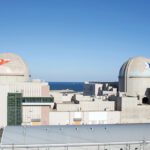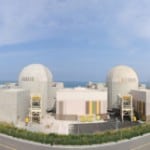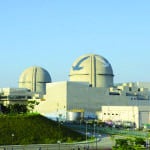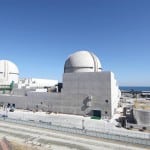The first of what could be as many as four APR-1400 nuclear reactors at the Shin Hanul site in South Korea is now supplying electricity to the country’s power grid.
Unit 1 at Shin Hanul is a 1,400-MW reactor. It was connected to the grid on June 9, just more than two weeks after the pressurized water reactor reached first criticality on May 22, according to officials with Korea Hydro & Nuclear Power (KHNP).
South Korean officials said Shin Hanul, located in Uljin on the country’s east coast, is part of the new government’s strategy to achieve energy security while also supporting environmental goals. The start-up of the reactor comes three months after the election of Yoon Suk-yeol as South Korea’s new president. Suk-yeol has said he plans to reverse the strategy of former President Moon Jae-in, who wanted to phase-out nuclear power generation. Jae-in adopted that policy after he assumed office in 2017, in part citing the 2011 Fukushima Daiichi accident in Japan.
Suk-yeol, though, has said nuclear power must continue to be part of South Korea’s energy mix, and said his administration is looking into restarting construction of two more APR-1400s at Shin Hanul. Suk-yeol has said he wants to continue to operate the country’s current nuclear reactors for a longer period, and his administration has said nuclear should continue to supply about 30% of South Korea’s electricity.
Design First Used at Shin Kori
The first two APR-1400 reactors, Units 3 and 4 at Shin Kori in South Korea, entered commercial operation in December 2016 and September 2019, respectively. Construction of two more APR-1400s, designated as Shin Kori Units 5 and 6, began in April 2017 and September 2018, with those reactors scheduled to be commissioned in March 2023 and June 2024, respectively.
Sama Bilbao y León, World Nuclear Association Director General, in comments shared with POWER on June 10, said, “Shin Hanul 1 will make a significant contribution to reducing South Korea’s use of fossil fuels, providing affordable, secure, low-carbon electricity. I want to offer my congratulations to Korea Hydro & Nuclear Power (KHNP), the Korean Nuclear Safety and Security Committee (NSSC) and all of those who have contributed to bring this reactor into service.”
Bringing Shin Hanul 1 online culminates a nine-year construction process for the reactor. Groundbreaking for the first two units at Shin Hanul, which was formerly known as Shin Uljin, began in May 2012. Construction on Units 1 and 2 moved ahead, with the reactors originally expected to come online in April 2017 and April 2018, respectively, before running into roadblocks, including Jae-in’s phase-out policy that threatened ongoing nuclear projects. Construction of Units 3 and 4 at Shin Hanul also was put on hold.
Amid construction delays, fuel loading for Unit 1 pushed back to June 2019. That work was initially postponed after regulatory agencies called for more safety checks and modifications. The Nuclear Safety and Security Committee (NSSC) gave conditional approval for start-up of Unit 1 on July 9, 2021, and KHNP began loading the first of the fuel assemblies into the core of the reactor on July 14 of last year. KHNP in October 2021 said that after loading fuel, it was conducting reactor physics and systems testing under normal operating temperature and pressure conditions. KHNP had earlier said would take about eight months to complete those tests, in line with the eventual start-up date.
60-Year Design Life
The APR-1400 is an evolutionary pressurized water reactor, based on the Combustion Engineering, or CE, System 80+ model. The reactor is principally designed by Korea Engineering Company, with 1,400-Mwe generation capacity and a 60-year design life.
Officials said the APR-1400 supplants the standardized 995-MWe OPR-1000, a Generation II reactor developed by KHNP and Korea Electric Power Corp. (KEPCO). Officials and nuclear engineers in South Korea said the APR-1400 features improvements in operation, safety, maintenance, and affordability. KHNP in announcing the grid connection said Shin Hanul 1 is the first nuclear power reactor in the country to achieve “technological independence,” primarily through localization of core facilities, such as the reactor coolant pump and the plant instrumentation and control system.
The APR-1400 reactor design was approved by European Utility Requirements—a technical advisory group for European utilities on nuclear power plants—in October 2017. The U.S. Nuclear Regulatory Commission in August 2019 certified the APR-1400 meets U.S. nuclear safety requirements.
The Barakah nuclear power plant, the first nuclear generation in the United Arab Emirates and a POWER Top Plant award winner in 2021, has four APR-1400s. Barakah represents the first export of the APR-1400 design. The first two units at Barakah were connected to the grid over the past two years.
KHNP in April of this year said it was in discussions with Poland on exporting the technology for the construction of up to six APR-1400 reactors in that country.
“In the face of astronomically high fossil fuel prices, and the urgent need to tackle climate change, governments worldwide need to rapidly accelerate the deployment of new nuclear capacity,” said Bilbao y León. “While South Korea’s brief flirtation with nuclear phase-out certainly delayed progress, the commitment of the new administration to support its nuclear energy industry, both in South Korea and in the growing export markets, is very welcome.”
—Darrell Proctor is a senior associate editor for POWER (@POWERmagazine).










